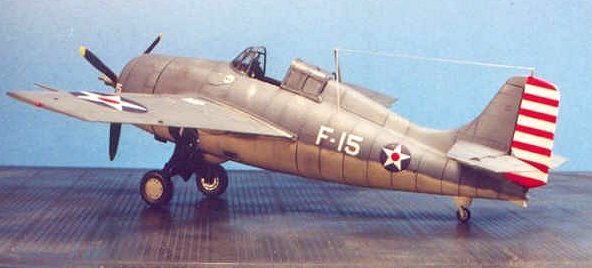
|
KIT: |
Tamiya 1/48 F4F-3 Wildcat |
|
KIT # |
61034 |
|
PRICE: |
$26.00 |
|
DECALS: |
Three aircraft |
|
REVIEW & |
|
|
NOTES: |
-Just Plane Stuff
F4F-3 Conversion |

|
HISTORY |
The F4F-3 "Wildcat" was the outcome of a development process by Grumman aircraft to meet a 1938 U.S. Navy requirement for the fighter to replace the F3F series. The Navy, while wanting to obtain a monoplane fighter that would be close in performance to its land-based opponents, was also conservative in its planning; Grumman, as the company that had created the F3F, was asked to create another biplane fighter - the XF4F-1 - while Brewster would build a monoplane, the XF2A-1. Grumman foresaw correctly that the biplane was a dead-end, and managed to convince the Navy that with a few modifications the F3F-2 could meet the requirements of the XF4F-1; this was ordered into production as the F3F-3, and Grumman was able to proceed with its own monoplane design, the XF4F-2.
How it was that the XF4F-2, built by the Navy's premier fighter design company, lost out to the XF2A-2 - the first aircraft design of a company primarily known for building horse-drawn buggies, a company with no experience of aircraft production or facilities to do so - is one of those bureaucratic mysteries that has never been fully explained, the moreso since both aircraft were so close in performance that they were twins. Luckily for the Navy and history, Grumman prevailed on the Bureau of Aeronautics to allow them to rework the design a third time, to create the XF4F-3. This fighter was a marginally-better performer than the F2A-1, which had just entered production; Brewster was already demonstrating its inability to meet any production schedules, and the Navy was glad to be able to order the new fighter from the more reliable company.
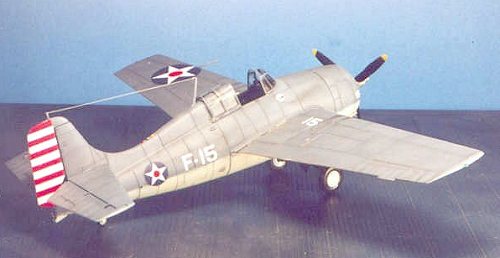 The first production
F4F-3 was flown in February 1940, powered by a Pratt and Whitney R-1830-76 Twin
Wasp with a two-stage supercharger, with the second following that July. These
and the next eight F4F-3s were involved in tests by the Navy to change the
cooling flaps and exhaust to get rid of exhaust seepage in the cockpit and to
improve engine cooling. In April 1940, due to fears of production delay with
the two-stage supercharger, the Navy asked Grumman to re-engine the airplane
with the R-1830-90 Twin Wasp with single-stage supercharger. This emerged into
production as the F4F-3A, 55 of which were given to the Marines in 1941, since
they had shown they did not have the necessary high-altitude performance with
the single-stage supercharger. The last 100 F4F-3s were powered by the
R-1830-86 Twin Wasp with a two-stage supercharger; these were visually
differentiated from the early F4F-3s and F4F-3As by the absence of the intake on
the upper cowling, that having been moved inside the cowl.
The first production
F4F-3 was flown in February 1940, powered by a Pratt and Whitney R-1830-76 Twin
Wasp with a two-stage supercharger, with the second following that July. These
and the next eight F4F-3s were involved in tests by the Navy to change the
cooling flaps and exhaust to get rid of exhaust seepage in the cockpit and to
improve engine cooling. In April 1940, due to fears of production delay with
the two-stage supercharger, the Navy asked Grumman to re-engine the airplane
with the R-1830-90 Twin Wasp with single-stage supercharger. This emerged into
production as the F4F-3A, 55 of which were given to the Marines in 1941, since
they had shown they did not have the necessary high-altitude performance with
the single-stage supercharger. The last 100 F4F-3s were powered by the
R-1830-86 Twin Wasp with a two-stage supercharger; these were visually
differentiated from the early F4F-3s and F4F-3As by the absence of the intake on
the upper cowling, that having been moved inside the cowl.
The first F4F-3s equipped VF-41 aboard the "Ranger" on December 4, 1940, and soon after by VF-42, followed closely by VF-71 and VF-72 aboard the "Wasp" in February 1941. VF-6 turned in their F3F-2s for F4F-3s in June 1941, while VF-3 exchanged their F2A-1s for F4F-3s in October 1941, as did VF-5. VMF-121 and VMF-211 were also equipped with F4F-3s while VMF-111 flew the F4F-3As. The airplane also received the emotive name "Wildcat" in November 1941.
The first F4F-3s to see combat were the 12 Wildcats of VMF-211 at Wake Island. All but four were lost on the first day, though during the next two weeks those four were kept operational by cannibalizing the wrecks. The Wildcats turned back several Japanese bombing raids from the Marshall Islands, and even sank a destroyer during the first invasion attempt, which was turned back. The "Hiryu" and "Soryu" were detached from the returning Pearl Harbor strike force to support the invasion. On December 22, the last two Wildcats were written off in landings after suffering damage in combat with Zeros. The next day, the Marines on Wake Island were forced to surrender.
The F4F-3 next saw action in early February when the "Enterprise" and "Yorktown" with VF-6 and VF-42 respectively embarked, struck the Marshall and Gilbert Islands. In the meantime, VF-3 aboard the "Lexington" was about to see action to test the theory that "the bomber will always get through" and that carriers could not withstand a determined attack by land-based air forces.
"Butch" O'Hare Saves The
"Lexington":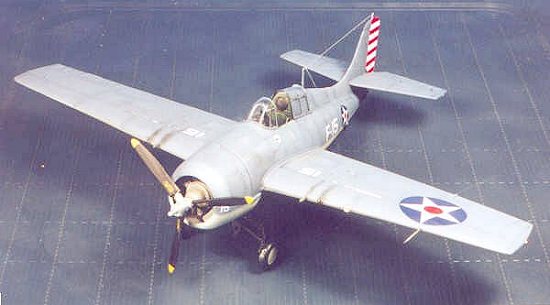
Edward H. "Butch" O'Hare - born in St. Louis and raised in Chicago - graduated from the U.S. Naval Academy in 1937. After two years of sea duty aboard the U.S.S. "New Mexico," he was sent to Pensacola in 1939, earning the designation of Naval Aviator in May, 1940, at which time he was assigned to VF-3, then aboard the "Saratoga."
LT. John Thach, then Executive Officer of VF-3, discovered O'Hare's exceptional abilities as a fighter pilot, and took the young man as his wingman. Thach emphasized gunnery in his training - as did every USN Fighter Squadron XO (unlike their Army compatriots). O'Hare was a standout. At the fleet gunnery competion at the end of 1940, 8 of 16 VF-3 pilots qualified for the covered "Gunnery E," and O'Hare won the fleet trophy for best gunnery.
Saving the Lexington:
On February 20, 1942, the "Lexington" was approaching New Ireland from the north to strike Japanese shipping at Rabaul. While still 400 miles from the target, the task force made a radar contact 35 mules out. Squadron CO Thach led the first division off for intercept, with the second 4-plane section under Squadron XO LCDR Don Lovelace orbiting the task force. Vectored in and out of clouds and squall lines, Thach's division finally found an H6K Mavis hiding in a rain squall. With his wingman making a portside high overhead pass, Thach initiated a starbord overhead pass; the combined fire ignited the fuel tanks of the big "Mavis," which spun into the ocean below. 50 minutes later, two more VF-3 Wildcats of Lovelace's division spashed a second "Mavis," but the task force had been discovered. The "Lexington" was about to find out if a carrier task force could stand up to a determined land-based bombing attack.
At 1630, 17 G4M1s of the 4th Air Group approached from Rabaul in two formations - one 9-plane formation from the starboard side, one 8-plane formation from port. Each was armed with two 550-lb armor-piercing bombs. The Japanese were 25 miles from the task force when radar picked up the eight planes of the first formation. Things could not be worse for the "Lexington," as LCDR Lovelace's division had just entered the landing pattern after the launch of the relief CAP under LT Noel Gaylor.
The Japanese came over the task force and turned to attack from astern, losing precious minutes. Lovelace's division, gulping their last gallons of fuel, hit the Bettys as a unit, disrupting the bomb run - the nearest explosion was 3,000 yards from "Lexington." As Gayler's CAP made their run - losing two to the 20mm tail stingers of the "Bettys" - Thach was launched again with a 6-plane CAP. As Thach and three of his pilots hit the Bettys - with Thach splashing two of them - the last two members of the CAP were ordered to orbit the ship. Butch O'Hare and Lt.(j.g.) Marion Dufilho felt frustration as they watched the rest of the CAP chase away the surviving Bettys. At this moment, 16 of the squadron's 18 aircraft were commited to the engagement.
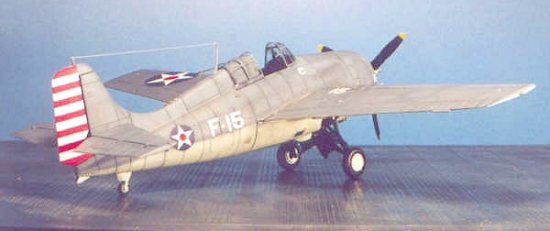 At 1700, the
"Lexington" picked up the second formation on its CXAM radar. The Bettys were
only 12 miles out, on the disengaged side of the task force, completely
unopposed. The order to O'Hare and Dufilho was "Buster." Climbing as fast as
they could, they arrived 1,500 feet above the attacking Bettys only 9 miles
out. As they rolled into a starboard high-side pass, the Bettys began
descending in a fast shallow dive toward "Lexington."
At 1700, the
"Lexington" picked up the second formation on its CXAM radar. The Bettys were
only 12 miles out, on the disengaged side of the task force, completely
unopposed. The order to O'Hare and Dufilho was "Buster." Climbing as fast as
they could, they arrived 1,500 feet above the attacking Bettys only 9 miles
out. As they rolled into a starboard high-side pass, the Bettys began
descending in a fast shallow dive toward "Lexington."
As O'Hare lined up on his first target, Dufilho dove away with jammed guns. The winner of the Fleet Gunnery Competion was about to enter the only show that counted.
Tracers from the nine bombers streaked past as he closed to a range of 100 yards. He took aim at the starboard engine of the last plane in the V of V's and opened fire. The hits were so concentrated that the engine on the Betty literally jumped out of its mountings. As the first victim spun toward the sea, O'Hare tore up his second target with another concentrated burst. Pulling out of his pass, he came up on the last Betty on the other side of the V and blew up its port engine. He turned and banked for a second pass, burning another.
Thach later reported that at one point he saw three bombers falling in flames at the same time as he and his section joined the fight. O'Hare made his third high-side pass, into the flak bursts from "Lexington's" anti-aircraft fire, as every one of the surviving Japanese bombers opened fire. O'Hare blew up the lead bomber as his guns rattled empty. The four surviving Bettys placed their bombs within 100 yards of "Lexington's" stern. Thach's four Wildcats intervened at that moment and shot down two of the survivors.
The value of the Navy's emphasis on gunnery training for its fighter pilots had been more than fully demonstrated. When O'Hare climbed out of his cockpit upon landing, his first request was for a glass of water; he downed four before leaving the flight deck. Against the loss of two F4Fs and one pilot, VF-3 had downed fifteen of seventeen attackers, including two that ditched on the way home. It has later been determined that O'Hare only shot down four of the attackers, though a fith was one of the two that ditched. Afterward Thach figured out O'Hare had used only sixty rounds of ammunition for each plane he destroyed.
For this feat, in which he had probably saved the "Lexington," Edward H. "Butch" O'Hare became the first Naval Aviator of the Second World War to win the Medal of Honor, and the only one of eight Wildcat pilots to win this honor who was carrier-based.
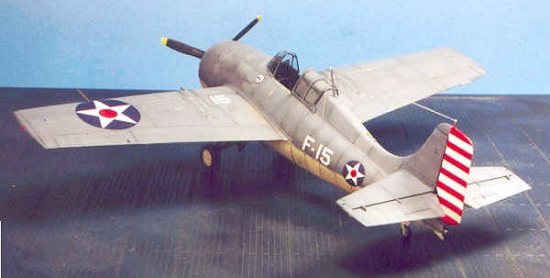 When he completed his
tour of the U.S. to sell war bonds after being decorated at the White House,
O'Hare rejoined VF-3 in 1943 in Hawaii. There he met a young Naval Reserve
Ensign just out of flight school who showed the same kind of promise O'Hare had
shown Thach. LCDR O'Hare made ENS Alex Vraciu his wingman, and taught him
everything he knew, taking Vraciu with him when he was given command of VF-6.
On November 27, 1943, during an experimental night interception mission over the
Gilbert Islands, O'Hare was lost in circumstances which have never been fully
explained.
When he completed his
tour of the U.S. to sell war bonds after being decorated at the White House,
O'Hare rejoined VF-3 in 1943 in Hawaii. There he met a young Naval Reserve
Ensign just out of flight school who showed the same kind of promise O'Hare had
shown Thach. LCDR O'Hare made ENS Alex Vraciu his wingman, and taught him
everything he knew, taking Vraciu with him when he was given command of VF-6.
On November 27, 1943, during an experimental night interception mission over the
Gilbert Islands, O'Hare was lost in circumstances which have never been fully
explained.
Alex Vraciu demonstrated he had learned well as he went on to become the top ace of the Navy by the second anniversary of O'Hare's mission of February 20, 1942, ending the war as the fourth-ranked Navy ace. To this day, he will tell anyone who asks (as I did 10 years ago) that "Butch O'Hare was the greatest fighter pilot and the best officer I ever knew."
Today, if you visit the Main Terminal at O'Hare International Airport in Chicago, you can see an F4F-3 retrieved from the depths of Lake Michigan, restored as the Wildcat Chicago's son flew on that memorable mission. It is the centerpiece of the terminal.
|
THE KIT |
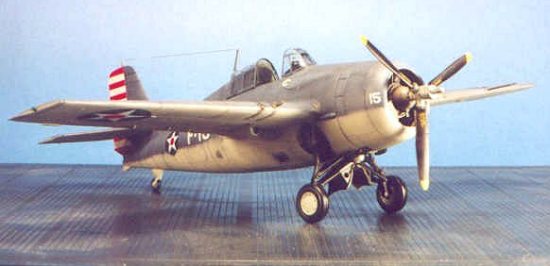 What can be said about Tamiya's Wildcat that hasn't been said a hundred times? It is one of the
company's best releases, and is perhaps the best-engineered, most easy to
assemble plastic airplane model ever created. The only complaint modelers have
about it is Tamiya stopped with the F4F-4, when they could have gone on (as
Hasegawa would have) to make the F4F-3 and the FM-2.
What can be said about Tamiya's Wildcat that hasn't been said a hundred times? It is one of the
company's best releases, and is perhaps the best-engineered, most easy to
assemble plastic airplane model ever created. The only complaint modelers have
about it is Tamiya stopped with the F4F-4, when they could have gone on (as
Hasegawa would have) to make the F4F-3 and the FM-2.
Fortunately, Dave Schemel of Just Plane Stuff has come to the rescue with a resin conversion for the F4F-3 that completely overshadows the previous attempt at doing this by KMC (now long out of production). The conversion set has been previously reviewed here at Modeling Madness . Price has not been announced yet, but the full conversion set will include decals for early F4F-3s, F4F-3As and late production F4F-3s, and will also likely provide the Falcon/Squadron vacuform canopy, so that it can be posed open.
Comparing this wing - which was designed from measurements taken from the F4F-3 that is displayed at O'Hare International airport in Chicago - one discovers that most of the drawings of the F4F-3 (such as those in the "F4F in Detail and Scale" book) are wrong. It is now finally possible to make a completely accurate F4F-3 Wildcat.
|
CONSTRUCTION |
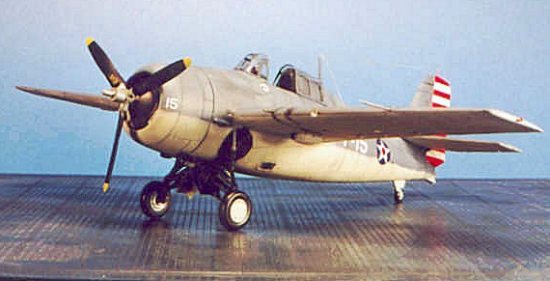 The Just Plane Stuff
conversion replaces the engine cowlings, the lower cockpit interior and the
seat, and the wing of the Tamiya kit. The parts fit perfectly to the Tamiya
fuselage, though it is necessary to cut a "notch" in the wing root of the
fuselage parts, to go over the brass spar in the conversion wing. Past this,
everything fits as easily as do the original Tamiya parts. I did find it
necessary to sand down the wing surface, because the resin had a slightly-pebbly
surface. This was likely due to it being a test shot. Additionally, the
hatches for the flotation bags in the outer wing are molded to stand proud of
the surface, and need to be sanded down until they are almost completely flush
with the rest of the wing surface.
The Just Plane Stuff
conversion replaces the engine cowlings, the lower cockpit interior and the
seat, and the wing of the Tamiya kit. The parts fit perfectly to the Tamiya
fuselage, though it is necessary to cut a "notch" in the wing root of the
fuselage parts, to go over the brass spar in the conversion wing. Past this,
everything fits as easily as do the original Tamiya parts. I did find it
necessary to sand down the wing surface, because the resin had a slightly-pebbly
surface. This was likely due to it being a test shot. Additionally, the
hatches for the flotation bags in the outer wing are molded to stand proud of
the surface, and need to be sanded down until they are almost completely flush
with the rest of the wing surface.
The cowlings for the early production F4F-3, F4F-3A and late production F4F-3 are provided. After test-fitting the parts of the cowling for the late-production F4F-3 I was making, I decided it would be easier to take the kit cowling and sand off the upper intake lip, since the flap pattern was the same for the late production F4F-3 and the F4F-4. I also cut off the cheek intakes of the kit cowling and replaced them with the better-looking and more accurate resin intakes provided by Just Plane Stuff. The crankcase of the kit engine with the twin magnetos was replaced by the resin crankcase provided.
The seat has the lap belts molded in, which I particularly liked. Remember that US Navy aircraft did not use shoulder harnesses until June 1942; the F4F-3 saw all its operational service with lap belts only.
Overall, the model assembled as easily as it would have if I had been building the kit out of the box.
|
PAINT & DECALS |
The F4F-3 was originally delivered from the factory in the pre-war "golden wings" scheme. These airplanes were repainted overall light grey in the fall of 1940. The F4F-3As and the late-production F4F-3s were delivered from the factory in the overall grey scheme, and were repainted in October 1941 with the upper non-specular blue-grey color. Thus, the camouflage pattern differed from unit to unit, and you should look at photographs of the F4F-3 you want to do to determine that. Fortunately, there are several photos of VF-3 Wildcats, and it is clear that the demarcation was at about the centerline of the fuselage for this unit's airplanes.
I used Gunze-Sanyo H-42 "Blue Grey" for the upper color, and Gunze-Sanyo H-51 "Light Gull Grey" for the lower color. After pre-shading the model with black, I lightened the Blue Grey after initial application and faded the paint as it would have been after operating in the South Pacific.
Decals:
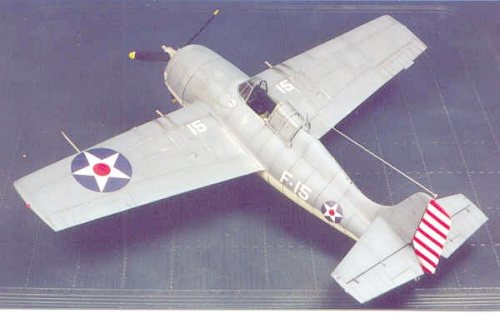 The Aeromaster sheet
48-167C "F4F Wildcat Aces Part 1" - which is now back in production by Eagle
Strike - has the markings for BuNo 4031, "F-15", the Wildcat flown by Butch
O'Hare on his Medal of Honor mission, February 20, 1942 (though, interestingly,
the sheet lists April 21, 1942 as the date of this mission). The red/white
rudder stripes on this decal sheet are too small to be used, but fortunately the
Tamiya kit decals include these strips in the right size; under a couple
applications of "Mr. Mark Softer" from Gunze, these quite-thick kit decals set
down nicely. The Aeromaster decals are Cartograph, and required a final "heavy
artillery salvo" of Solvaset after two applications of Micro-Sol to set down
properly.
The Aeromaster sheet
48-167C "F4F Wildcat Aces Part 1" - which is now back in production by Eagle
Strike - has the markings for BuNo 4031, "F-15", the Wildcat flown by Butch
O'Hare on his Medal of Honor mission, February 20, 1942 (though, interestingly,
the sheet lists April 21, 1942 as the date of this mission). The red/white
rudder stripes on this decal sheet are too small to be used, but fortunately the
Tamiya kit decals include these strips in the right size; under a couple
applications of "Mr. Mark Softer" from Gunze, these quite-thick kit decals set
down nicely. The Aeromaster decals are Cartograph, and required a final "heavy
artillery salvo" of Solvaset after two applications of Micro-Sol to set down
properly.
Final Assembly:
After the decals set, I washed the model to get rid of the solvent residue, then gave it another coat of Future. When this was dry, I dry-brushed Testors Model Master Metalizer non-buffing Aluminum on the wings and around the cockpit for scuff marks, as well as some "chips" around the gun bays, engine access panels, etc. I then shot two coats of thinned Testor's Dullcote, after which I used Tamiya "Smoke" for the gunblast residue and exhaust stains, which were then given a single light coat of Dullcote to make them semi-gloss instead of full-gloss which you get with "Smoke" paint.
I then assembled the landing gear and inserted it in the wells and attached the prop. I used the Squadron vacuform canopy for the Tamiya kit, since it can be posed open.
I then assembled the landing gear and inserted it in the wells and attached the prop. I used the Squadron vacuform canopy for the Tamiya kit, since it can be posed open.
|
CONCLUSIONS |
If you like the Wildcat, you will want to pick up this conversion from Just Plane Stuff. It is highly accurate, and very easy to use. I am sure I will eventually do an early-production F4F-3 with this set once it comes out with decals.
And the good news is, Mr. Schemel informs me he is going to visit a "locally-based FM-2" over the winter. Thus good things will come to those who wait, and an FM-2 conversion of similar quality should be appearing this coming summer (or so - I'm not his production manager).
Thanks to Just Plane Stuff for the review sample.
If you would like your product reviewed fairly and quickly by a site that has over 100,000 visits a month, please contact me or see other details in the Note to Contributors.